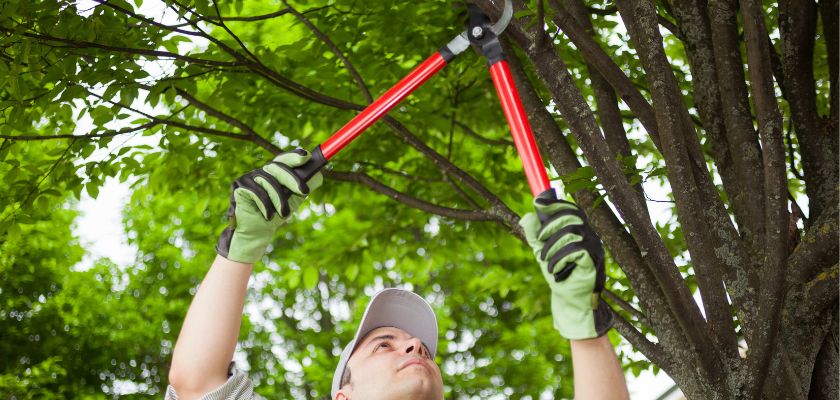In the field of arboriculture, knowing how to prune trees properly is crucial to preserving their beauty, safety, and well-being. We at Texas Tree Transformations recognize the need to use appropriate tree-pruning techniques. We explore a range of pruning methods in this article, from simple upkeep to sophisticated tactics, to help you improve the health and beauty of your trees.
Table Of Content
The Importance of Tree Pruning
Promoting Growth and Health
Pruning trees is essential for encouraging healthy growth because it gets rid of unhealthy, diseased, or dead branches that might limit the tree’s ability to expand. Pruning improves the general health and vitality of the tree by getting rid of these unwanted components and rerouting the tree’s energy into new development.
Enhancing Structural Stability
Proper pruning techniques help improve the structural integrity of trees by reducing the risk of weak or overextended branches that could pose a safety hazard. Strategic pruning can encourage the development of a strong central leader and well-spaced branches, reducing the likelihood of breakage during storms or high winds.
Improving Aesthetics
Tree pruning is also a valuable tool for enhancing the aesthetic appeal of trees, shaping them to fit their surroundings and complementing the landscape design. Whether creating a formal, manicured look or preserving a more natural appearance, thoughtful pruning can elevate the visual appeal of trees and enhance the overall beauty of outdoor spaces.
Basic Tree Pruning Techniques
Deadwooding
In emergencies, such as after a storm or when dealing with hazardous situations, Emergency Tree Pruning is crucial. Deadwooding involves the removal of dead or dying branches from the tree canopy. These lifeless limbs not only detract from the tree’s appearance but also pose a safety risk, as they can fall unexpectedly. Deadwooding promotes tree health and reduces the likelihood of branch failure.
Thinning
Thinning entails the selective removal of branches to reduce canopy density and improve light penetration and air circulation within the tree. Thinning helps alleviate stress on branches and promotes even growth throughout the canopy, resulting in a healthier and more balanced tree.
Crown Raising
Crown raising involves the removal of lower branches to increase clearance beneath the tree canopy. This technique is commonly used to provide clearance for pedestrians, vehicles, structures, or sightlines, enhancing safety and accessibility in urban and suburban settings.
Advanced Tree Pruning Techniques
Pollarding
Pollarding is a radical pruning technique that involves the removal of the upper branches of a tree to promote the growth of a dense head of foliage and branches below. This method is often used to control tree size, rejuvenate overgrown trees, or produce a distinctive aesthetic effect.
Espalier
Espalier is an ancient horticultural technique that involves training a tree to grow flat against a support structure, such as a wall or fence, in a specific pattern or shape. This method is used to create ornamental features, maximize space in small gardens, or optimize fruit production in orchards.
Canopy Reduction
Canopy reduction, also known as crown reduction, is a pruning technique used to reduce the size and spread of a tree’s canopy. This method involves selectively removing branches to decrease overall canopy volume while maintaining the tree’s natural form and structure. Canopy reduction is often employed to mitigate hazards, alleviate wind resistance, or manage tree size in confined spaces.
Final Thoughts
Gaining expertise in tree trimming methods is crucial to enhancing the beauty, safety, and well-being of trees. The vitality, structural stability, and aesthetic appeal of trees may all be improved with appropriate pruning techniques, whether simple maintenance is done or more sophisticated approaches are used.
You can guarantee your trees’ long-term health and beauty by knowing the fundamentals of tree trimming and using the right methods. In order to assist you in reaching your tree care objectives and creating a flourishing outdoor environment, Texas Tree Transformations specializes in providing professional tree trimming services. Get in touch with us right now to arrange a consultation and learn how our skilled trimming methods may completely change your trees.
FAQ’s
The frequency of tree pruning depends on factors such as tree species, age, and health. Generally, it’s recommended to prune young trees annually to shape their growth and mature trees every 3-5 years to maintain their health and structural integrity.
While trees can be pruned throughout the year, the best time for pruning depends on the species. For most trees, late winter or early spring, before new growth begins, is ideal. However, some flowering trees should be pruned after they bloom to avoid cutting off next year’s flower buds.
When pruning trees, focus on removing dead, diseased, or damaged branches first, as well as any crossing or rubbing branches. Additionally, thinning out dense areas of the canopy can improve airflow and light penetration, promoting overall tree health.
Proper pruning can reduce the risk of storm damage by removing weak, overextended, or hazardous branches that could break during high winds or severe weather. Regular pruning also promotes overall tree health, making trees more resilient to environmental stressors.
Yes, over-pruning, or excessive pruning, can harm trees by removing too much foliage, weakening the tree’s structure, and reducing its ability to photosynthesize and produce food. It’s essential to follow proper pruning practices and avoid removing more than 25% of a tree’s canopy at once.

